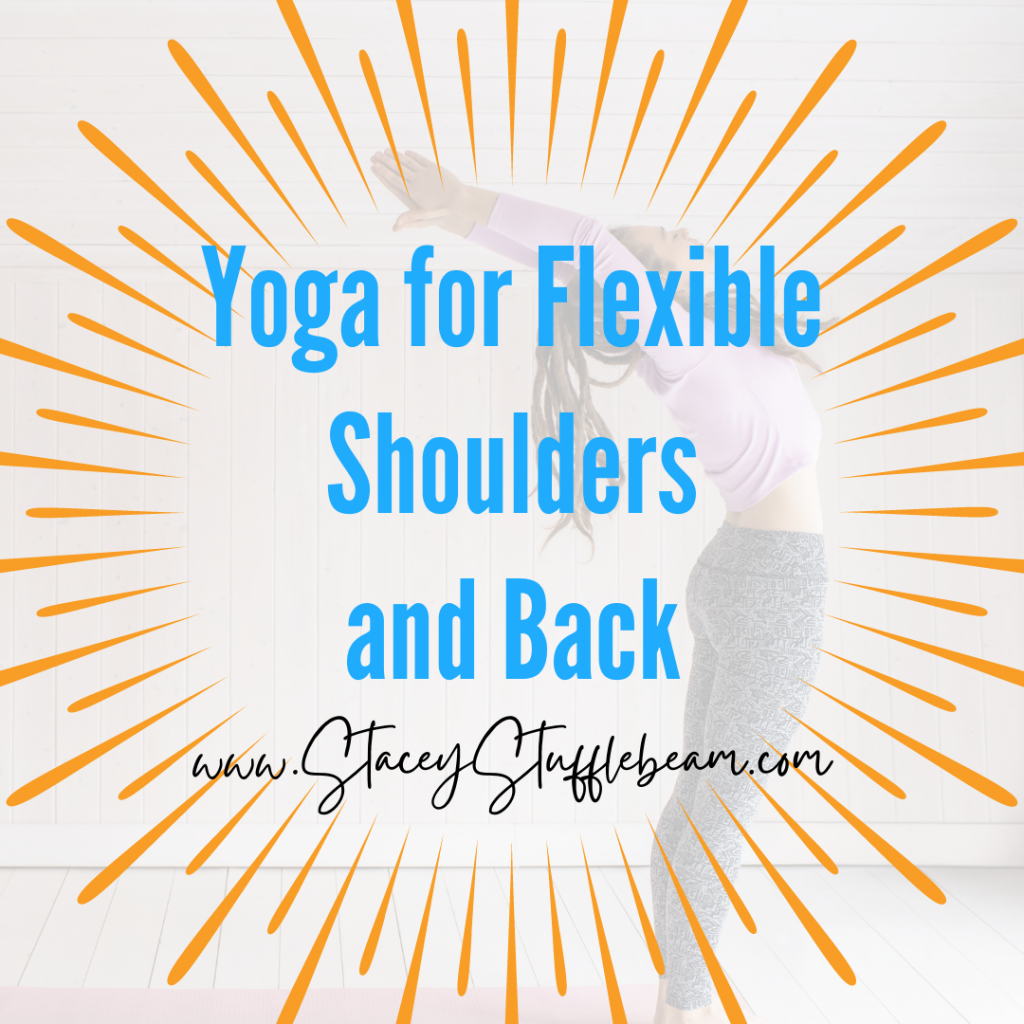Did you know that yoga can increase back and shoulder mobility, range of motion, and flexibility?
These two parts of our bodies are so interconnected that tightness in one can lead to pain or limited mobility in the other. Many of the movements we do in our daily lives cause us to bend forward such as texting, driving a car, using a computer, sitting for extended amounts of time, and carrying heavy bags or even a baby. That strain from everyday activities creates tension in our upper bodies. Yoga, on the other hand, can increase flexibility in our shoulders and back.
Limited range of motion in our upper body can restrict our daily activities.
Stress, tension, and overuse can also result in our shoulders and upper back feeling tight or stiff. Our lower backs may get sore from tight hamstrings or hips because when our hamstrings shorten, they pull down on our pelvis, which in turn puts tension on our low backs. Weak muscles, poor posture, and incorrect body alignment can also lead to tightness in these areas.
The shoulder is the body’s most complicated joint. It’s where the ends of the collarbone, upper arm bone, and shoulder blade meet. The surrounding muscles need to be long and flexible to stay healthy to prevent injury.
It’s important to stretch our shoulders and backs regularly to loosen and strengthen the muscles. Releasing tension in the upper body can improve our overall feelings of well-being.
Getting on our yoga mats for a few classes each week helps to improve flexibility in our back and shoulders tremendously! But on those days when we are feeling especially tight or don’t have time for a full class, a few minutes on our mats with the right asanas (poses) can really help us feel better.
The following yoga poses can help increase flexibility, extend your range of motion, and prevent injury. Work through them slowly and do not move into any painful positions. Stay within a range that is comfortable for you. (Don’t worry. That range will increase with practice and patience.)
Yoga Sequence for Flexible Shoulders and Back
Child’s Pose (Balasana)
Child’s Pose opens the shoulder joint into flexion (forward bending) and stretches the upper back muscles. The lower back is also stretched when the knees are kept close together.
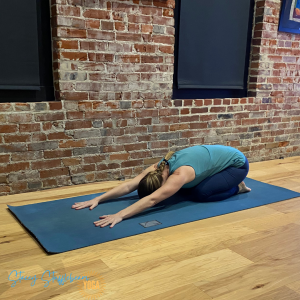
From Table Pose on your hands and knees, untuck your toes and reach your arms forward on your mat. Then sit your hips back toward your heels. Drape your belly over your thighs. Finally, bring your forehead to the mat or a block for extra support. Let your body relax in this pose for five breaths.
Cat-Cow Vinysasa (Marjaryasana-Bitilasana)
This vinyasa moves all the muscles in the torso. The entire length of the back is stretched in Cat Pose. The shoulders and hips move in and out of flexion during the transitions.
Come into Table Pose on your hands and knees. Line up your knees directly under your hips and your wrists directly under your shoulders.
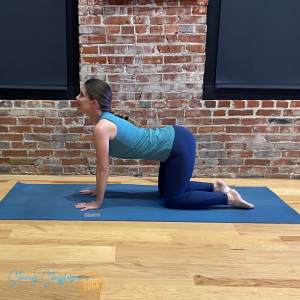
Inhale and lift your tailbone, drop your belly, reach your heart forward, and lift your chin to come into Cow Pose.
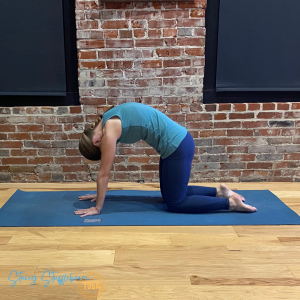
As you exhale, tuck your tailbone, pull your belly toward your spine, round your back, and tuck your chin toward your chest for Cat Pose.
Do a total of 10 rounds. Inhale for Cow Pose. Exhale for Cat Pose.
Thread the Needle (from table) Pose (Parsva Balasana)
Thread the Needle Pose can mean 2 completely different poses. Parsva Balasana can mean 2 different poses as well. The result? Three poses. Jeez! Whatever you call it, this is an excellent pose to stretch your shoulders and back.
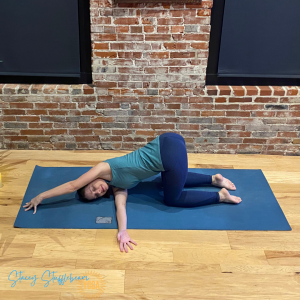
Come back to Table pose. Inhale and lift your right arm out to the side and up toward the sky. Exhale and bring your arm back down and all the way through the space between your left arm and left leg. Bend your left elbow. Let the back of your right hand slide along the floor while reaching as far as you comfortably can to the left. Bring the right side of your head and your right shoulder and arm down onto the ground. Allow your right hand to relax with your palm facing up.
To increase the stretch in the front of your left shoulder, come onto your left fingertips or walk your left hand toward the top of your mat.
Hold for 5 – 10 breaths. Repeat on the other side.
Cobra Pose (Bhujangasana)
As you stretch the front of your chest and shoulders in Cobra Pose, the muscles of the upper back get a chance to contract. Ultimately, this will allow the upper back to relax and feel better.

Come down onto your belly. Bend your elbows back to bring your hands under your shoulders. Inhale and slowly lift your head and chest off the mat. Keep the front of your pelvis on the mat. Contract the muscles between your shoulder blades to draw the shoulders back and open the chest.
Hold for 5 – 10 breaths. Slowly release back to the mat on an exhale.
Cow Face Pose (Gomukasana)
This is the most intense pose of the series. It’s a deep stretch for the shoulders and hips. If it feels too intense, back off and breathe deeper. This pose doesn’t have to be done all together to be effective. You can do the two parts separately. For example, in a comfortable seated position, work only on opening the shoulders. Then release the arms and practice stacking the knees with your hands on the mat. The goal is to feel better through progress, not perfection.
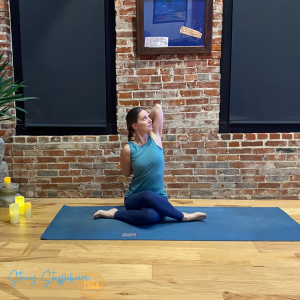
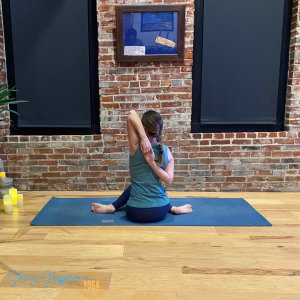
For the full pose, come into a seated position. Cross your right knee over your left. Bring your feet back toward your hips. Relax your knees toward the mat.
Inhale, lift your left arm toward the sky. Exhale and bend your elbow to bring your left hand behind your neck. Bring your right hand to your left elbow to help nudge your left hand further down your back. Exhale and bring your right arm down. Bend your right elbow to bring your hand behind your back. Walk your hands closer together. Clasp your hands if possible or grab the back of your shirt or use a yoga strap to make the bind.
Stay for 5 – 10 breaths before doing the same thing on the opposite side. (Left knee and right arm on top.)
Reclined Queen’s Pose
This one needs some props (2 blocks and a bolster) and takes some time to set up but once you’re in it, it’s worth it! Trust me. This restorative pose opens the chest, shoulders, and hips while relaxing the back.
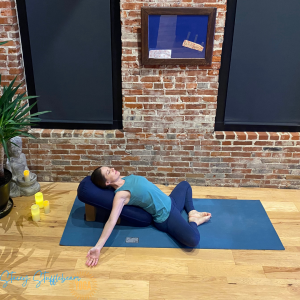
Place your blocks parallel with the top of your mat about a foot apart. Put the block closer to the top of your mat on its tallest height. The other block will be on its middle height. Then place your bolster diagonally over your blocks with the end furthest from the top of your mat resting on your mat so that it looks like a ramp.
Sit on your mat so that your low back touches the bolster. Bring the bottoms of your feet together with your knees wide into Bound Angle Pose. Then, slowly lower your back onto the bolster. Keep your spine in the middle. Relax your head onto the bolster.
Stretch your arms out and let the backs of your hands rest on the floor if they reach.
Close your eyes and stay for 1 – 5 minutes.
Yoga helps increase back and shoulder flexibility.
It’s a good idea to stretch your shoulders and back frequently to prevent severe tightness. These yoga poses can help increase back and shoulder flexibility, extend their range of motion, and prevent injury. Try to bring your awareness to these areas of your body throughout the day, and work on relaxing and releasing tension both on and off the yoga mat.
This is the third article in our Flexible February series. Access the other articles by clicking the links below:
Flexibility for Hips and Hamstrings
Our weekly articles are for people looking for more joy in their lives by helping to feel better mentally and emotionally through mindfulness and conscious physical movement. This creates more gratitude and contentment both on and off the yoga mat. Don’t miss one! Get them delivered directly to your inbox every Tuesday by signing up below. 😊

